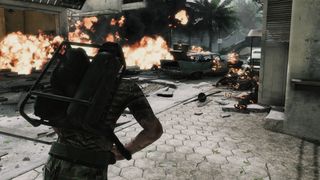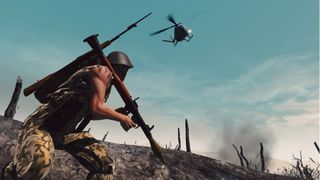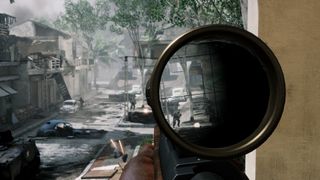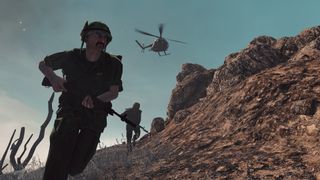
If war never changes, then neither does Tripwire Interactive’s proficiency at depicting it in the multiplayer shooter scene. Its plaudits back up that reputation, including two Multiplayer FPS Game of the Year awards in 2011 and 2013 for Red Orchestra 2: Heroes of Stalingrad and Rising Storm, respectively. Now, it’s going for the hat-trick with Rising Storm 2: Vietnam, developed by Antimatter Games, the team behind Rising Storm, and overseen by publisher Tripwire. Set in the sorely underutilized Vietnam War, Rising Storm 2 pairs battles of up to 64 players with the series’ staple focus on realism, asymmetry, and impactful weapon power—but it also adds extra delights such as pilotable helicopters and new modes harnessing the skirmish-heavy style of deep jungle warfare.
Still not convinced? Read on for specific reasons why Rising Storm 2: Vietnam stands out and why it deserves a slot in your Steam library. By the way, you’ll be able to jump into an open beta between the 19th and 22nd—a great opportunity to try everything firsthand ahead of the game’s May 30th release. If you’re excited to play, you’re in luck: the Digital Deluxe Edition is 25% off its $30/£23 price up until launch and contains extra goodies, including exclusive camouflaged boonie hats for both factions, a lowland ERDL camouflaged helmet and Darkhorse pilot helmet for the US forces, a headscarf and camouflaged Ushanka hat for the Vietnamese troops, and the official soundtrack. Check out the Steam page for more details.

Both armies look, feel, and play different
Choosing to join either the Americans or Viet Cong isn’t just a simple surface-level change of uniform and team designation. As was successfully implemented in its brother games, Rising Storm 2 emphasizes different playstyles by conveying the stark differences in military hardware, tactics, and weaponry reflective of the actual conflict’s unconventional asymmetry. In the context of the Vietnam War, it’s American presence against Vietnamese mobility; area-wide napalm strikes countering stealthy underground tunnels, overwhelming force multipliers versus guerrilla hit-and-run ambushes.
In gameplay terms, you’ll spot both tiny and large contrasts between both playable factions. The availability of helicopters means American players can choose to spawn as a pilot to rapidly chop in additional troops to hotzones or swiftly deliver death from above with rocket barrages and strafing runs. The VC responds with subtlety, traversing the map via underground tunnels and avoiding aerial detection by keeping crouched or prone. The VC can strike suddenly from multiple angles, feeding a suspenseful paranoia for the US as a balance against their superior firepower. On the flipside, hawkeyed US teammates that spot VC can quickly clear an area by setting up napalm and AC-47 Spooky minigun runs via binocular-directed strikes. The VC can sabotage critical objectives and chokepoints with traps and can more easily melt into the jungle foliage with the ready abundance of tunnels. Smaller characteristics set both armies apart, as well, such as the visual differences in running animations, the adornment of armor and headwear, and how weapons are held.

Combat strives for authentic deadlines
While other games such as Battlefield toe the line between realism and fantasy with forgiving weapon properties, Rising Storm 2’s assortment of guns handle as close to their real-life counterparts as possible with slight adjustments in performance in the interest of balance. With the painstaking research Tripwire is known for, the attention to detail is quite unparalleled. You’ll see and experience specific examples in how each of the game’s over 30 guns react to either carefully aimed shots or wild sprays of automatic fire. Various elements such as stance, heart rate, distance, breathing, bullet drop, and nearby objects to steady your weapon will affect your accuracy and recoil control. Caliber matters, as well—you’ll withstand more kick shooting the VC’s AK-47-modeled Type 56 assault rifle than the American M16, for example.
That devotion to immersion extends to how you absorb information during the course of battle. A minimalist HUD eschews health and ammo counts; you have to manually eject your magazine and count bullets to keep track of the latter. There’s no on-screen crosshair, and your bullets will travel where your gun’s barrel points. Directional in-game cues—both audio and visual—point the way to shifting frontlines and nearby activity instead of resorting to a minimap. Taking fire or surviving danger-close explosions punishes accuracy with a heavy suppression effect. All of this reinforces Rising Storm 2’s strengths of pushing a more cautious and aware mindset to its players, a refreshing change from the standard run-and-gun fare of today’s popular shooters.

Squad roles serve meaningful purposes
Each member of a squad in Rising Storm 2 brings tangible, significant perks to their teammates. Even if you elect to spawn as a standard rifleman, you’re provided a suite of tools and utilities to reinforce the heavy teamwork aspect necessary to accomplish objectives and secure victory. The examples are numerous: squad leaders serve as personified spawn points for their squad and are equipped with binoculars for relaying enemy positions—VC squad leaders can dig extra tunnels as added spawn areas for their team. Pilots ferry reinforcements to the front and provide aerial reconnaissance. The commander calls in scout planes and airstrikes, but they can’t do it until they reach a radioman who functions as a mobile communications relay for coordinating strikes.
Equally useful is the set of squad management tools available to players for organizing, naming, and shuffling personnel in squads. These added touches of logistics greatly aid in determine who belongs to which squad in the field. More importantly, each squad boasts dedicated VOIP channels, a critical component for calling out intel to your team and discussing tactical options.

Progression is nuanced but fair
Ascending the ranks in Rising Storm 2 isn’t a surefire road to increasingly powerful weapons and equipment as found in other shooters. Rather, the game’s progression system focuses on receiving unique and faction-specific cosmetic options. As a result, the playing field is kept as even as possible. You won’t have to worry about being fragged by a double-velocity grenade from an underslung launcher only earned after getting 200 kills with the knife.
The duds you’ll earn will push a great deal of variance in appearance for either your American or VC soldier. You’ll nab new headgear, clothing, tattoos, facial hair, and glasses among many others. You’ll also be able to select individual clothing styles for certain sections of your attire, such as rolled-up sleeves or torn pant legs. Essentially, you’ll hit the jungle with a soldier tailored for a personalized look, and Rising Storm 2’s progression system ensures continual play to bolster the wardrobe but keep the arsenal stocked just as well as rank 1.
Sponsored by Tripwire
PC Gamer Newsletter
Sign up to get the best content of the week, and great gaming deals, as picked by the editors.
